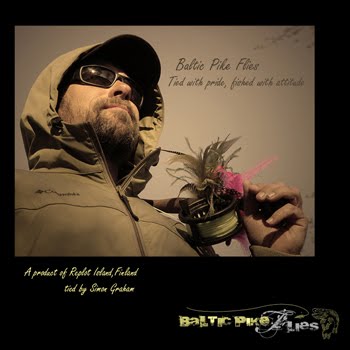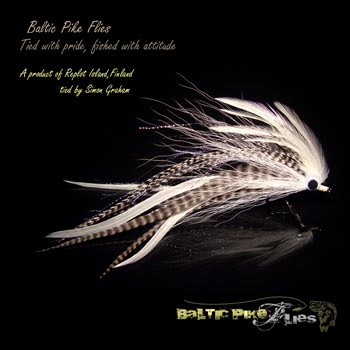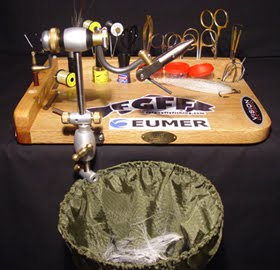
Fishing as much as I do here on the island I’ve had to develop certain flies for specific areas and types of fishing. 50% of my fishing is spent wading in water no deeper than 3ft. The other 50% is spent either fishing from elevated rocks into drop off channels, or from a boat. Due to the unique topography this island has, its one of the few places in the world where the land mass rises between 7.5mm – 9mm per annum which has given rise to literally thousands of extremely shallow bays lined with the flattened remains of the previous years reed beds, perfect for spawning pike to take advantage of. Mapping charts have to be changed here every 10 yrs due to the shore line getting wider and wider. Not only that but it’s estimated that there are more boulders found here than in the Himalayas. I know hard to believe but it’s true. This not only makes wading extremely treacherous but also challenging.
When I visited and fished the area 5 yrs ago before moving here, I didn’t enjoy the experience at all. I was constantly getting snagged up on the rocks so over the last 4 yrs I’ve had to evolve, or should I say adapt my fishing to suite my surroundings. One of these adaptions has been the use of bend-back hooked flies, or flies with upturned hook points with counter weight balances like my Rattle n Hums, designed to ride over boulders or through submerged reed roots.
Getting the balance right between the length of the bend in the hook shaft, the amount and type of materials used, as well as line and length of leader choice has seen these flies morph over the last couple of years into what I have here. Finding the right hook for the job has been a constant thorn in my side….well that’s until I started using Partridges Ultimate predator 4/0 hooks. They’re super sharp, light enough not to have the fly sink, yet have just the right length shank for this kind of application.

Pike here mainly gorge themselves on small perch, roach & sticklebacks for around three weeks prior to spawning and post spawn. So these flies are all around 100 mm -110 mm (4 & a half inches) in length. Anything bigger and they couldn’t be arsed in exerting the energy need to catch it. As you’ve probably noticed I love fishing with feathers. Four mixed coloured schlappen or Chinese cock saddles tied splayed outwards on to either side of the hook shank is all I need to get the job done. They have unbelievable movement under the water and weigh bugger all.

If I’m fishing from elevation, over drop off channels or from a boat, I generally fish with a Intermediate line & a 60lb 5ft mono leader (more on that later) but when fishing these shallow bays I use a floating line & a 25lb two and a half foot leader for a couple of reasons. Firstly the 25 lb mono doesn’t sink as quick, and secondly I fish these flies quite erratically. Water clarity here is phenomenal and varies between 2m – 8m, and I spend majority of my time sight fishing. Once I’ve spotted a pike and the fly has landed in close proximity to it, I give 4 or 5 short sharp strips to get its juices flowing. Then change over to single foot long sharp strips with the odd pause in between. Using a shorter leader of around two and a half feet like this with a tightly packed spun deer hair head, allows the energy from the strip to be transferred quicker from my fly line through the leader to the fly which results in the fly darting from side to side more than if I was using a longer leader.

Adding a deer hair collar to this kind of fly, gives it a natural weed guard especially if you add slightly more deer hair on top of the hook shank in front of the hook point. The tightly packed spun deer hair head should have a diameter of around 10mm and should also be slightly higher than the protruding point of the hook which also acts as an unintentional weed guard and gives the fly the perfect buoyancy I'd been looking for.

 Another favourite simple fly tied with white & yellow schlappen with a couple of white marabou hairline feathers palmered around the shank. Simple yet very very effective here on the Baltic.
Another favourite simple fly tied with white & yellow schlappen with a couple of white marabou hairline feathers palmered around the shank. Simple yet very very effective here on the Baltic.
 I started with tying on brown and chartreuse grizzly schlappen then added a peacock to either side of the hook. Added some grizzly microbarb saddles then a collar of deer plus a spun deer hair head.
I started with tying on brown and chartreuse grizzly schlappen then added a peacock to either side of the hook. Added some grizzly microbarb saddles then a collar of deer plus a spun deer hair head.  This is my 1st choice when I start fishing a yellow/white combo.
This is my 1st choice when I start fishing a yellow/white combo.
Lastly, the colour of the flies I use generally fish with are tied in these natural tan/browns with either yellow/white, Chartreuse/ brown, Orange/brown and also orange/ white feathers for tails, with a couple of strands of flash thrown into the mix. I’m busy working on a tutorial for this type of fly and although they might not suite everyone’s style of fishing or favourite venue they really do catch me a lot of pike in the spring when wading the shallows
Click images for larger view!




























4 comments:
Hi Simon,
Awesome read once again! It's always nice to read about fishing in different environments and the functional techniques involved.
I hear you Simon, we have a lot of boulders here as well (200 km south of Replot) but not to same extent as you have over there. They truly are a challenge when wading, especially when the waters are murky. Not to mention all the dents and bumps in the bottom of my boat....
Nice post with lots of great information and thoughts. Sounds like you have a very interesting place to fish. Thanks
Si,
Are those leaves I see on those trees? Could it be that spirg has sprung?
Glad to see that you're out and doing what you love.
John
Cheers lads,
Yes I am living in a remarkable place indeed. I'ts every hard to portray the place. Only until one has fished here will they understand what I mean.
John....Actually the images were taken last Autumn my friend. it wont be long here though before the Birch and willows have greenery though.
Post a Comment